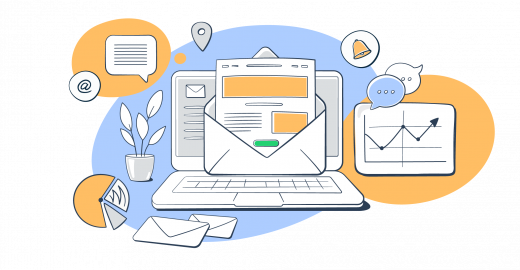With its proven efficiency, email marketing stands out as a direct and cost-effective strategy, boasting an impressive average return of $42 for every $1 spent, a testament to a well-executed email marketing strategy. However, its true potential is unleashed only with a well-defined newsletter strategy, key to driving value, boosting revenue, and attracting new customers.
An email newsletter strategy is a long-term plan designed to engage, communicate, and foster lasting relationships with a target audience through consistent email updates.
A successful email newsletter strategy considers the preferences and needs of the audience and aligns them with business objectives. It also continuously uses data-driven insights to refine and optimize email campaigns for maximum impact.
Some of the important elements of an email newsletter include:
- Audience segmentation
- Content design and creation
- Sending frequency
- Performance tracking
A well-defined email newsletter strategy should set clear and measurable objectives. For example:
- Acquire 500 new customers within the next quarter through targeted campaigns focusing on seasonal promotions.
- Increase engagement among the 25-35 age group by 20% over six months with bi-weekly newsletters featuring exclusive offers.
Key Benefits of a Strategic Email Newsletter Approach
- Enhanced Audience Engagement and Increased Brand Awareness
By incorporating elements of proper storytelling and brand identity, like logo design, color scheme, typography, and other relevant visuals, newsletters catch readers’ attention, reinforce brand awareness and increase engagement. This approach strengthens the connection with the audience and enhances long-term brand recognition.
- Effective Lead Generation and Customer Retention
A strategic newsletter approach can aid in acquiring quality leads by resonating with potential customers, enhancing the buyer’s journey, and retaining existing customers by offering personalized content. This ensures both the nurturing of new leads towards conversion and the re-engagement of inactive customers, fostering overall customer loyalty.
- Driving Traffic and Cost-Effective Marketing
Leveraging newsletters to drive more traffic to your website aligns with the cost-effective nature of email marketing. By crafting a type of content that aligns with audience interests and includes compelling calls to action, you not only increase website traffic but also do so in a budget-friendly manner.
- Define your newsletter’s purpose.
Every plan has to be purpose-driven to drive results. So before doing anything else, determine the whys behind your newsletter initiative. This gives your strategies a unified direction and keeps your efforts on track.
Start by understanding what you want to achieve with your newsletter strategy. Some common goals include:
- Increasing website traffic
- Generating leads
- Promoting products or services
- Positioning yourself as the niche expert
- Building brand awareness
- Driving sales
Here are some newsletter content ideas that will help you achieve different business goals:
- Understand and segment your target audience.
The key to a successful newsletter campaign is personalization. The more relatable your content is to the target audience, the better your results will be.
For that, just knowing who your target audience is won’t suffice. You must dive deeper into personas and segment your email list accordingly. That way, your newsletters will reach the right group of people with relevant content addressing their specific challenges. This will also help understand the options you’ll need when it comes to providing customer support and building good relationships with them – maybe you need a professional call center software to interact with them, maybe they prefer social media communication, or email is already enough.
Collect first-party and third-party data to gather information about your current newsletter subscribers and potential audience. Some useful data sources include:
- Signup forms
- Website analytics
- Customer surveys
- Social media platform insights
- Customer profiles
Divide your audience into different segments based on demographics such as age, gender, location, interests, behaviors, and purchase history.
- Build and organize your email list.
Following the understanding and segmentation of your target audience, building and organizing your email list is vital. This approach ensures a direct link between audience insights and list building.
- Focus on acquiring genuinely interested subscribers.
- Ensure new subscribers explicitly consent to your newsletters, reducing spam risks.
- Comply with GDPR, CAN-SPAM, and similar regulations.
- Regularly clean your email list by removing inactive subscribers to improve efficiency and ROI, ensuring a straightforward ‘unsubscribe’ option is available for users who wish to opt-out.
- Choose an email marketing platform.
Maintaining an email newsletter program manually is an impossible task. So, you should opt for an email marketing platform offering automation, analytics, and other necessary features that prioritize functionality.
Here are some elements you should look for while choosing the right digital marketing software:
- See which platforms offer features that align with your email marketing campaign goals. For example, if your primary purpose is generating leads, ensure your chosen solution has lead management features.
- Determine your budget and compare each tool’s features and affordability. This helps you to stay within your budget while getting all the necessary elements.
- Choose a user-friendly, easily adaptable email service provider that offers integrations so you don’t compromise your current workflow.
- Sign up for their free trial before making hefty investments.
- Ensure your chosen platform has a good reputation for email deliverability.
- Check its compliance with data protection regulations.
- Assess its scalability.
- Create a content calendar.
To maintain a high sending reputation and ensure consistent deliverability, it’s crucial to have a steady stream of content for your newsletters.
A content calendar helps align and schedule newsletter dispatches for consistent delivery and audience engagement. It aligns newsletters with key events and maintains seasonal relevance, ensuring timely communication. Using project management tools for monthly or quarterly planning sustains your sending reputation and keeps newsletters strategically focused.
- Design eye-catching email templates.
Begin with simple, uncluttered email template designs to avoid overwhelming your subscribers. Organize content clearly, emphasize key information, and prominently place call-to-action (CTA) buttons. Choose color schemes and fonts that reflect your brand and complement your content. Ensure your templates are responsive for a consistent look on mobile devices, and use white space effectively for a balanced, reader-friendly layout. Also, ensure your designs are compatible across various email clients to maintain visual appeal and functionality on any device. Many email marketing tools provide ready-to-use, high-conversion templates as an excellent starting point.
- Personalize email campaigns.
Personalize email campaigns by using recipients’ names in subject lines and tailoring content with product recommendations based on their purchase history. Customize offers based on location or time zone, ensuring incentives align with subscriber interests.
- Expanding your newsletter reach and retention.
Besides focusing on newsletter content creation and personalization, you must expand your subscriber list and retain the existing one. Here’s how:
- Communicate your value proposition. Let your email subscribers know what they gain from subscribing to your newsletter.
- Ensure your newsletter opt-in forms are prominently visible on your website’s high-traffic areas. However, their placement shouldn’t hinder the user experience.
- Offer incentives like discount codes, reports, and other free resources to encourage sign-ups.
- Share testimonials and reviews from satisfied subscribers to build trust and credibility.
- Promote the newsletters on your marketing channels.
- Implement A/B testing
How do you ensure your newsletter emails hit the mark with every segment? Run A/B testing. First, choose your variables for the test. Marketers mostly use A/B testing to assess the viability of elements like subject lines, sender’s name, content, images, calls to action, or frequency.
Create two or more versions of your newsletter, keeping all of the elements the same except for the variable you want to test. Then divide your subscriber list into random, mutually exclusive groups and send the versions to each. After implementing, ensure you collect enough data for statistical significance.
- Monitor and optimize
Monitor your campaign performance based on relevant metrics and KPIs. Common newsletter strategy metrics include email open rate, click-through rate, bounce rate, conversion rate, subscriber growth, retention, and ROI. Identify areas of improvement and perform relevant optimization to maintain growth.
Wrapping Up
While there is no definitive answer to “How much time does it take to create a newsletter strategy?” the key lies in putting in consistent effort and adapting to data-driven insights. You can develop a strategy that resonates with your audience by prioritizing high-quality subscribers, ensuring compliance with regulations, and regularly maintaining your email list. Remember, success in newsletter marketing doesn’t happen overnight. It requires ongoing dedication and the willingness to adapt and develop your approach based on audience feedback and engagement metrics. With persistence and strategic adjustments, your newsletter can become a favorite among your audience, fostering strong connections and driving effective results.



